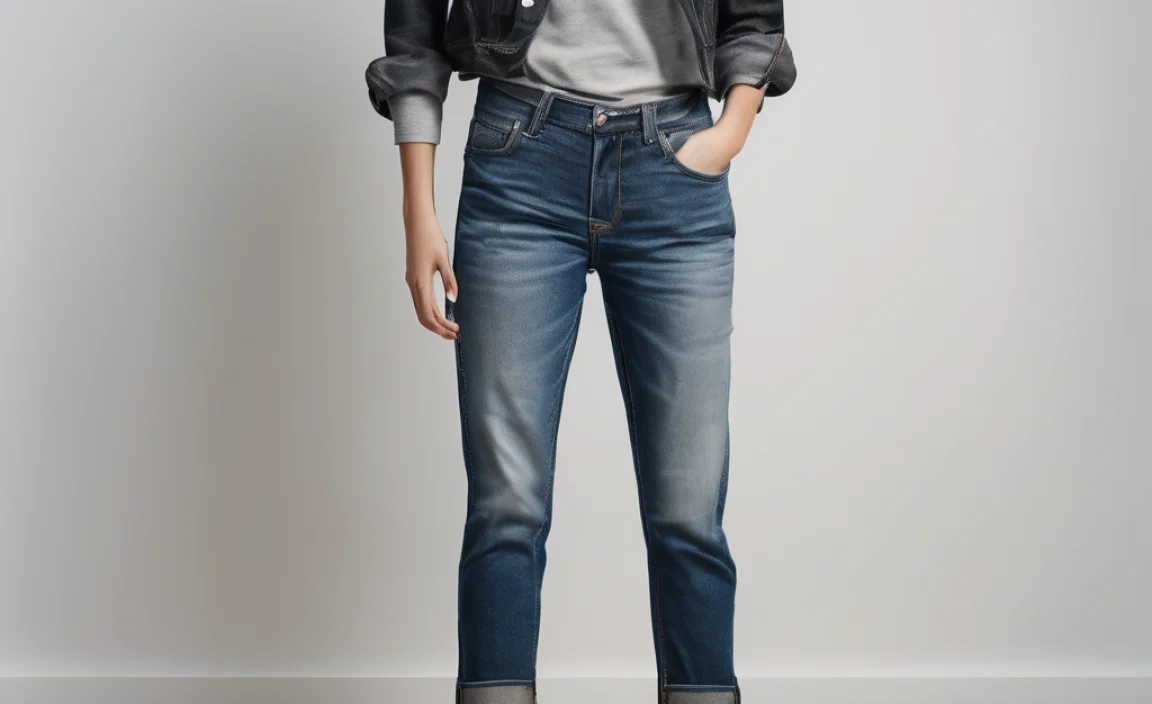Having trouble with the wide leg opening of your boyfriend jeans? This guide shows you exactly how to narrow them for a better fit, making them look more polished and stylish. Follow these simple, step-by-step instructions to achieve a custom look that flatters your shape.
How to Narrow Boyfriend Jeans: An Essential Guide for the Perfect Fit
Boyfriend jeans are a wardrobe staple, loved for their relaxed comfort and effortless cool. However, sometimes the leg opening can be a bit too wide, making them feel shapeless or overwhelming. If you find yourself wishing your favorite pair had a more tailored silhouette, you’re in luck! Narrowing the leg opening of your boyfriend jeans is a straightforward alteration that can make a big difference in how they look and feel. This guide will walk you through the process with clear, easy-to-follow steps, whether you’re a beginner sewer or just looking to give your denim a fresh update.
We’ll cover everything from measuring and preparing your jeans to executing the perfect seam. By the end, you’ll have the confidence to transform your denim, ensuring a fit that’s both comfortable and chic. Let’s get started and unlock the full potential of your boyfriend jeans!
Why Narrow Your Boyfriend Jeans?

Boyfriend jeans are designed to be a bit looser, but “loose” can sometimes translate to “baggy” if the leg opening isn’t quite right for your proportions. Narrowing them offers several benefits:
- Improved Silhouette: A slimmer leg opening can create a more flattering line, balancing out the relaxed fit of the rest of the jean and giving your legs a more streamlined appearance.
- Versatile Styling: Narrower jeans are often easier to style. They can be tucked into boots more neatly, look better with heels, and generally offer a more polished finish for various outfits.
- Personalized Fit: Denim is personal. What works for one person might not work for another. This alteration allows you to customize the fit to your exact preference.
- Reviving Old Jeans: If your current boyfriend jeans are feeling dated or just not fitting well anymore, this simple change can give them a new lease on life.
Tools and Materials You’ll Need

Gathering the right supplies before you start makes the process much smoother. Here’s what you’ll need:
- Your Boyfriend Jeans: The pair you want to alter.
- Fabric Scissors: Sharp scissors specifically for cutting fabric.
- Measuring Tape or Ruler: For accurate measurements.
- Fabric Chalk or a Removable Fabric Marker: To mark your cutting and sewing lines.
- Straight Pins: To hold the fabric in place while sewing.
- Sewing Machine: A home sewing machine will make this job much faster and neater. Ensure it’s threaded with a strong, suitable thread.
- Thread: A durable thread that matches or complements your jeans’ color. Denim-specific thread is ideal if you have it.
- Seam Ripper: Useful for carefully removing existing seams if needed, though for narrowing a leg opening, it’s often not necessary unless you’re taking them apart completely.
- Iron and Ironing Board: For pressing seams flat as you go.
- Optional: Tailor’s Ham: A curved pressing tool that helps shape seams, especially useful for curved areas like leg openings.
Step-by-Step Guide: How to Narrow the Leg Opening of Boyfriend Jeans

Let’s get down to business. Follow these steps carefully for a successful alteration.
Step 1: Prepare Your Jeans
Start with your jeans clean and dry. Lay them flat on a clean, hard surface, smoothing out any wrinkles.
- Ensure the jeans are laid out perfectly flat, with the legs one on top of the other. This is crucial for ensuring both legs are altered symmetrically.
- Check the existing seam on the inner leg. This is where you’ll be making most of your alterations.
Step 2: Measure and Mark the New Leg Opening
This is a critical step for achieving the desired fit. Decide how much narrower you want the leg opening to be.
How to Measure:
- Determine Desired Width: Try on the jeans. Pinch the fabric on the outer seam of the leg from the hem upwards to visualize how narrow you want them to be. A common approach is to reduce the width by 1-2 inches on each side (meaning a total reduction of 2-4 inches in circumference).
- Mark the Current Hem: Place the jeans flat and use your fabric chalk or marker to mark a line at the current hem, directly on the outer seam.
- Mark the New Hem Line: Measure your desired reduction (e.g., 1 inch) from the original outer seam inwards. Mark this new line running parallel to the original outer seam, all the way up the leg. Do this on both the inner and outer seams of each leg opening.
- Create a Guide Line: You’ll be sewing a new seam that runs from your marked point on the outer seam, tapering up the leg to meet the original seam somewhere above the knee or mid-thigh. The exact point where the new seam meets the old seam depends on the amount you’re tapering and your desired look. A common starting point is to have the taper run up to meet the existing seam around the widest part of the calf or just above it.
- Mark the Sewing Line: Draw a chalk line that starts at your inner seam mark, curves gently to connect with your outer seam mark, and then runs straight up to meet the original seam line. You’ll be sewing along this line. You want to create a smooth transition.
Tip: It’s often easier to taper the outer seam more significantly than the inner seam, or vice-versa, to create a specific silhouette. However, for a straightforward narrowing, a symmetrical alteration is common. Consider the natural shape of your leg when deciding where the new seam will end.
Step 3: Pin the New Seam
Once your lines are marked, it’s time to secure the fabric.
- Fold the denim along your marked sewing line.
- Pin the folded fabric securely in place, running pins perpendicular to your chalk line. Ensure the fabric is smoothly aligned and there are no puckers. Pin all the way up to where the new seam will meet the old seam.
- Repeat this on the other leg of the jeans, ensuring the pinning is as symmetrical as possible.
Step 4: Sew the New Seam
Now, you’ll stitch the new shape into your jeans.
- Set up your sewing machine: Use a strong needle (denim or heavy-duty needle) and durable thread. Set your machine to a straight stitch with a medium length (around 2.5-3.0 mm).
- Start Sewing: Begin at the hem, right on your chalk line. Backstitch a few times to secure the beginning of the seam.
- Sew the Taper: Sew slowly and steadily along the chalk line, guiding the fabric gently. Continue sewing up the leg until you reach the point where your chalk line meets the original seam.
- Finish the Seam: At the end of the new seam, backstitch a few times to reinforce it.
- Repeat on Other Leg: Carefully repeat the sewing process on the other leg, aiming for identical results.
Important Note on Seam Allowance: You are essentially creating a new seam on the “outside” of the existing seam allowance. Your sewing line should be approximately your desired seam allowance (e.g., 1/2 inch to 5/8 inch) away from the raw edge of the fabric that you’ve folded over. This is the part that will become the new leg opening.
Step 5: Trim Excess Fabric and Finish the Hem
After sewing, you need to tidy up the raw edges.
- Trim: Carefully trim away the excess fabric that is now on the inside of the leg, using your fabric scissors. Leave about a 1/2 inch seam allowance beyond your new stitching line.
- Finish the Raw Edge: To prevent fraying, you have a few options:
- Serge/Overlock: If you have a serger, use it to finish the raw edge.
- Zigzag Stitch: Use a zigzag stitch on your sewing machine along the raw edge. This is a common and effective method for denim.
- Pinking Shears: For casual denim, pinking shears can provide a basic fray prevention.
- Press: Iron the newly sewn seam flat. This helps it lie neatly and gives your jeans a professional finish. You can press the seam allowance to one side, similar to how you’d press a standard garment seam, or press it open if you’ve constructed it that way.
Step 6: Try Them On and Adjust
The best way to check your work is to try them on!
- Put on the jeans and check the fit of the new narrow leg opening.
- Walk around, sit down, and see how they feel.
- Make any minor adjustments needed. If one leg is slightly off, you can unpick a few stitches and re-sew.
Alternative: Narrowing for a More Dramatic Taper

If you want to transform your jeans from a wide-leg boyfriend style to something closer to a slim-fit or even a tapered leg, you’ll need to take in more fabric from the inseam and potentially the outseam, starting higher up the leg.
When This Method is Useful
- You want a significant change in silhouette.
- Your current boyfriend jeans resemble straight-leg jeans with an overly wide hem.
- You’re aiming for a style that is closer to a mom jean or slim-fit jean.
Steps for a More Dramatic Taper:
- Marking: Lay the jeans flat. Decide how much you want to take in. This will likely involve creating a new seam that starts much higher up the leg. For a dramatic taper, you might start taking width from your thigh or even your knee. You’ll draw a new seam line that runs from the original inseam or outseam seam (depending on where you want to remove fabric) and tapers down to your desired new leg opening.
- Sewing: Sew this new, longer seam. You will be removing a larger triangle of fabric from the leg.
- Trimming and Finishing: Carefully trim the excess fabric and finish the raw edges as described previously.
Caution: Taking in too much fabric too high up the leg can alter the intended fit and comfort of boyfriend jeans. Always measure and mark carefully, and consider trying on the jeans with pins in place before sewing.
Table: Common Boyfriend Jean Leg Opening Widths vs. Narrowed Options

Here’s a general guideline for leg opening widths. Your personal preference will dictate your target measurement.
| Jean Style | Typical Leg Opening Width (measured flat across the hem) | Considered “Narrowed” Width (measured flat across the hem) | Notes |
|---|---|---|---|
| Standard Boyfriend Jeans | 8 – 10 inches (20 – 25 cm) | 7 – 8 inches (18 – 20 cm) | Offers a relaxed but not overly wide look. |
| Extra Wide Leg Boyfriend Jeans | 10 – 12+ inches (25 – 30+ cm) | 8 – 9 inches (20 – 23 cm) | Significantly reduced for a more streamlined silhouette. |
| Boyfriend Jeans leaning towards Straight Leg | 7 – 9 inches (18 – 23 cm) | 6 – 7 inches (15 – 18 cm) | Results in a cleaner, more tailored appearance. |
Note: These are approximate widths. Always measure your own jeans and consider your body shape and desired style.
Table: Troubleshooting Common Issues
Even with careful work, you might encounter small problems. Here are solutions.
| Problem | Possible Cause | Solution |
|---|---|---|
| Jeans look asymmetrical after altering. | Legs weren’t perfectly aligned when marking or pinning. | Unpick the seam on the uneven leg and re-mark and re-sew, ensuring perfect alignment. |
| Uneven stitching. | Machine tension issues or inconsistent sewing speed. | Adjust machine tension, practice on a scrap piece of denim, and sew slowly and deliberately. |
| Fabric is puckering along the new seam. | Pins were too far apart, or fabric shifted during sewing. | Use more pins placed closer together. Ensure fabric is smooth and aligned directly under the presser foot. |
| Needle is too dull or thread is too thick. | Use a sharp denim needle and appropriate thread. Ensure the needle is inserted correctly. | |
| New hem looks uneven or wavy. | Uneven trimming of excess fabric. | Carefully re-trim the excess fabric to ensure a consistent allowance before finishing the hem. |
| Stitching frayed slightly. | Raw edge not finished properly. | Re-finish the raw edge with a zigzag stitch or serger for better fray prevention. |
Frequently Asked Questions (FAQ)
Q1: How much fabric can I realistically take off the leg opening of my boyfriend jeans?
You can usually take off anywhere from 2 to 4 inches in total circumference from the leg opening for a noticeable, yet still flattering, change. Taking off too much can make the jeans look unnaturally tight in the calf and ankle area, losing the original boyfriend charm. Always measure and try on to get it right.
Q2: Do I need a special sewing machine or needle for denim?
While a standard sewing machine can work, using a denim or heavy-duty needle is highly recommended. Denim needles are sharper and stronger, preventing skipped stitches and needle breakage. A sturdy thread, like a polyester durable thread, is also better than standard all-purpose thread for the best longevity.
Q3: What is the best way to finish the raw edge after cutting?
The most common and effective methods are using a zigzag stitch on your sewing machine or an overlock (serger) stitch if you have one. These methods prevent fraying and create a clean finish. For a more casual look, pinking shears can also offer some fray resistance, but a stitched finish is more durable.
Q4: Can I narrow the leg opening without sewing?
For boyfriend jeans, sewing is the most durable and best-looking solution for narrowing the leg opening. Temporary fixes like fabric tape might hold for a very short time but will not withstand wear and washing, and they can create stiffness or visible lines. For a lasting alteration, sewing is the way to go.
Q5: How do I ensure both legs are narrowed equally?
The key is symmetry from the start. Lay the jeans perfectly flat, one leg directly on top of the other. Measure and mark both legs simultaneously or one after the other with extreme care. Use plenty of pins to hold the fabric precisely in place before sewing. Check your markings and the pinned fabric from multiple angles.
Q6: What if I make a mistake and need to unpick my stitches?
Don’t worry! Making mistakes is part of the learning process. Use a seam ripper carefully to remove the stitches. Once unpicked, smooth out the fabric, re-mark your lines, and try again. It might take a second attempt to get it perfect, and that’s perfectly okay.
Q7: Can this method be used on other types of jeans?
Yes, the principles of narrowing a leg opening apply to many styles of jeans, including straight-leg, bootcut, and even some looser-fit skinny jeans. The amount you take in and where you end your new seam will vary greatly depending on the original jean style and your desired outcome.
Additional Tips for a Professional Finish
To elevate your altered jeans from homemade to high-street, consider these pro tips:
- Pressing is Key: Don’t skip ironing. Pressing the seams as you complete them, and then pressing the finished jeans, makes a world of difference in achieving a sharp, polished look. A tailor’s ham can be invaluable for pressing curved seams smoothly.
- Match Your Thread Color: While contrast stitching can be a design element,











